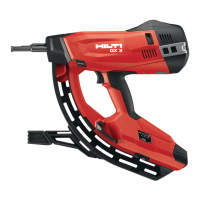4
▶ Do not attempt to drive fasteners into materials that are too soft,suchaswoodordrywall/gypsum
board. Attempting to drive fasteners into these materials may lead to malfunctions and fasteners being
driven incorrectly or driven right through the material.
▶ Do not attempt to drive fasteners into materials that are too brittle, such as glass or tiles. Attempting
to drive fasteners into these materials may lead to malfunctions, fasteners being driven incorrectly and
may cause the material to shatter.
▶ Before driving fasteners, check that there is no risk of injuring persons or of damaging objects present
behind or below the working surface.
▶ Pull the trigger only when the fastening tool is pressed against the working surface in such a way that
the fastener guide is pushed into the nose of the tool as far as it will go.
▶ Always wear gloves if you have to carry out maintenance work on the fasteningtoolwhileitis
still hot.
▶ If fasteners are driven at a high rate or if the tool used for a long period, surfaces of the tool beyond the
grip areas may get hot. Wear protective gloves to avoid burning injuries.
▶ If the fastening tool overheats, remove the gas can and allow the tool to cool down. Do not exceed the
specified maximum fastener driving rate.
▶ Driving fasteners may cause flying fragments or result in parts of the nail strip material being forcibly
ejected from the tool. Flying fragments present a risk of injury to the body and eyes. Wear eye
protection and a hard hat. Other persons in the vicinity must also wear eye protection and a hard hat.
▶ Wear your personal protective equipment and always wear protective glasses. Depending on the
application and type of tool in use, wearing personal protective equipment such as a dust mask,
non-slip safety footwear, hard hat and ear protection reduces the risk of injury.
▶ Wear suitable ear protection. Fasteners are driven through ignition of a gas/air mixture. The resulting
noise exposure may cause damage to the hearing. Other persons in the vicinity should also wear
suitable hearing protection.
▶ Observe the application guidelines concerning minimum fastener spacing distances and distances from
edges of the material ( → page 7).
▶ When driving a fastener, always hold the fastening tool securely and at right angles to the supporting
material. This helps to avoid deflection of the fastener by the supporting material.
▶ Never drive a second fastener at the same location. This may lead to breakage or jamming of fasteners.
▶ Alway remove the gas can and ( → page 10) empty the magazine ( → page 11) before changing the
magazine, before cleaning, servicing or maintenance work on the tool, before storage or transport and
before leaving the fastening tool unattended.
▶ To ensure that the fastening tool functions faultlessly and as intended, always check the tool and
accessories for possible damage before use. Check that moving parts function faultlessly, without
sticking, and that no parts are damaged. In order to ensure faultless operation of the tool, all parts must
be fitted correctly and must meet the necessary requirements. Damaged protective devices or other
parts must be properly repaired or replaced by Hilti Service unless otherwise stated in the operating
instructions.
▶ Have the fastening tool repaired only by trained and qualified specialists using genuine Hilti spare parts.
This will ensure that the safety of the fastening tool is maintained.
▶ Tampering with or modification of the fastening tool is not permissible.
▶ Do not use the fastening tool where there is a risk of fire or explosion.
▶ Take influences of the surrounding area into account. Do not expose the fasteningtooltorainorsnow
and do not use it in damp or wet conditions.
▶ Use the fastening tool only in well-ventilated working areas.
▶ Select the correct combination of fastener guide and fastener. The wrong c
ombination may result in
damage to the tool and in reduced fastening quality.
▶ Always observe the application guidelines → page 7.
Hazards presented by electricity
▶ Before beginning work, check the working area (e.g. using a metal detector) to ensure that no
concealed electric cables or gas and water pipes are present.
▶ Hold the fastening tool only by the insulated grip when working in areas where fasteners may be driven
inadvertently into concealed electric cables. Contact with a live electric cable may cause metal parts of
the tool also to become live, leading to a risk of electric shock.
Instructions for handling the propellant gas
▶ Observe the instructions printed on the gas can and in the accompanying information.
▶ Escaping gas is harmful to the lungs, skin and eyes. Keep your face and eyes away from the gas can
compartment for up to about 10 seconds after removing the gas can.

